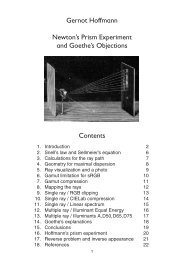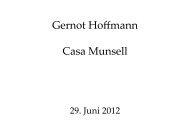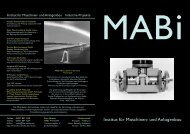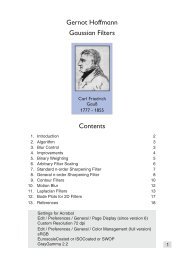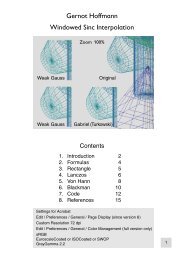Gernot Hoffmann Application of Quaternions
Gernot Hoffmann Application of Quaternions
Gernot Hoffmann Application of Quaternions
Create successful ePaper yourself
Turn your PDF publications into a flip-book with our unique Google optimized e-Paper software.
<strong>Gernot</strong> <strong>H<strong>of</strong>fmann</strong><br />
<strong>Application</strong> <strong>of</strong> <strong>Quaternions</strong><br />
The original report<br />
Anleitung zum praktischen Gebrauch von Quaternionen<br />
was written in February 1978<br />
for Pr<strong>of</strong>.Dr.J.Baumgarte<br />
Technische Universität Braunschweig<br />
Actual translation<br />
Composition by PageMaker<br />
No significant modifications<br />
Old pencil drawings<br />
January 20/2002<br />
Appendices contain newer information<br />
The practical application <strong>of</strong> quaternions<br />
is shown in Appendix A<br />
November 02/2002<br />
May 21/2005<br />
August 17/2005<br />
Website<br />
Please load browser and click here<br />
1
<strong>Application</strong> <strong>of</strong> <strong>Quaternions</strong><br />
Contents<br />
1. Definition and Features 3<br />
2. Rotational Transformations 5<br />
3. Transformation <strong>of</strong> Angular Velocities 7<br />
4. Rotational Equation <strong>of</strong> Motion in Euler Formulation 11<br />
4.1 Rotational Euler Equation by <strong>Quaternions</strong><br />
4.2 Transformation <strong>of</strong> Torques<br />
5. Rotational Equation <strong>of</strong> Motion in Lagrange Formulation 14<br />
5.1 Rotational Lagrange Equation by <strong>Quaternions</strong><br />
5.2 Transformation <strong>of</strong> Torques<br />
6. Transformations for Classical Euler Angles 16<br />
6.1 Rotational Transformations<br />
6.2 Transformations by <strong>Quaternions</strong><br />
6.3 Calculation <strong>of</strong> Angles<br />
7. Transformations for Aircraft Angles 18<br />
7.1 Rotational Transformations<br />
7.2 Transformations by <strong>Quaternions</strong><br />
7.3 Calculation <strong>of</strong> Angles<br />
8. References 20<br />
8.1 Original References<br />
8.2 References quoted from [1]<br />
9. Appendix A Rigid Body Rotation Half-Quat 21<br />
10. Appendix B Rigid Body Rotation Full-Quat 32<br />
11. Appendix C Spherical Linear Interpolation 37<br />
2
1. Definition and Features<br />
<strong>Quaternions</strong> are quadrupels <strong>of</strong> real numbers, for which a special multiplication is defined.<br />
(1.1) Q =<br />
The rules for the multiplication are easily understood if we represent the quaternions by three complex<br />
base vectors i, j, k. Then we have<br />
(1.2) Q = q 1 i + q 2 j + q 3 k +q 4 .<br />
The first three components can be written as a vector or column matrix q :<br />
(1.3) Q = q + q 4<br />
This scheme is valid for the multiplication, e.g. j·k = i :<br />
(1.4)<br />
q 1<br />
q 2<br />
q 3<br />
q 4<br />
Now we can already execute the multiplication <strong>of</strong> two quaternions Q and S. Opposed to matrix<br />
multiplications, we use always the dot.<br />
(1.5) P = Q·S<br />
(1.6) Q·S= (q 1 i + q 2 j + q 3 k + q 4 )·(s 1 i + s 2 j + s 3 k + s 4 ) = p 1 i + p 2 j + p 3 k + p 4 = p + p 4<br />
p1 q4 - q3 q2 q1 s1 p2 q3 q4 - q1 q2 s<br />
(1.7) =<br />
2<br />
p3 - q2 q1 q4 q3 s3 p4 - q1 - q2 - q3 q4 s4 The result <strong>of</strong> the multiplication is the product <strong>of</strong> the quaternion matrix R(Q) , which is assigned to Q,<br />
and the quaternion S, written as column matrix:<br />
(1.8) P = R(Q) S<br />
i j k<br />
i -1 k -j<br />
j -k - 1 i<br />
k j - i -1<br />
In [3] it is shown, that the multiplication can be executed by using normal, dot and cross products:<br />
(1.9) P = p + p 4 =(q 4 s 4 - q T s) + (q 4 s + s 4 q + q × s)<br />
It is q T s the dot product and q × s the cross product <strong>of</strong> the vector part <strong>of</strong> the quaternions.<br />
3
Each quaternion has a conjugate quaternion Q' :<br />
(1.10) Q' =<br />
- q 1<br />
- q 2<br />
- q 3<br />
+ q 4<br />
The multiplication is not commutative but associative:<br />
(1.11) Q 1 ·Q 2 ≠ Q 2 ·Q 1<br />
Q 1 ·Q 2 ≠ - Q 2 ·Q 1<br />
Q 1 ·(Q 2 ·Q 3 ) = (Q 1 ·Q 2 )·Q 3<br />
The following rule can be derived from Eq.(1.9) :<br />
(1.12) (Q·S)'= S'·Q'<br />
(1.13) S'·Q' = (q 4 s 4 - (-s) T (-q)) + (q 4 (-s) + s 4 (-q) + (-s)×(-q))<br />
=(q 4 s 4 - q T s) - (q 4 s + s 4 q + q×s) =(S·Q)'<br />
The norm <strong>of</strong> a quaternion is one or has to be made to one:<br />
(1.14) Q·Q' = q 1 2 + q2 2 + q3 2 + q4 2 = 1<br />
For Q = Q(t) we have<br />
· ·<br />
(1.15) Q·Q' + Q·Q' = 0 .<br />
Definition and Features<br />
William Rowan Hamilton (1805 - 1865) had invented the quaternions.<br />
Arthur Cayley (1821 - 1895) and Felix Klein (1849 - 1925) had contributed further.<br />
4
2. Rotational Transformations<br />
We consider quaternions with this structure and want to execute coordinate system rotations:<br />
(2.1) Q = cos(α/2) - n sin(α/2)<br />
The same physical vector x has the column matrix x 1 in coordinate system 1 and x 2 in system 2.<br />
System 2 is rotated relative to system 1 by a right screw rotation about n with the angle α .<br />
Then we have these transformations for the column matrices:<br />
(2.2) x 2 = Q·x 1 ·Q'<br />
(2.3) x 1 = Q'·x 2 ·Q<br />
We can verify this rule by an example.<br />
Rotate by α about the axis z 1 .<br />
Note: the rotation axis vector n has the same column matrices n 1 = n 2 in both coordinate systems.<br />
For the special case we assign k to n and get:<br />
(2.4) Q = cos(α/2) - k sin(α/2)<br />
(2.5) Q' = cos(α/2) + k sin(α/2)<br />
(2.6) x 2 = ( cos(α/2) - k sin(α/2) )·(x 1 i + y 1 j + z 1 k)·( cos(α/2) + k sin(α/2) )<br />
x1 [ cos2 (α/2) - sin2 (α/2)] + 2y1 [ sin(α/2)cos(α/2) ]<br />
(2.7) x2 = -2x1 [ sin(α/2)cos(α/2) ] + y1 [cos2 (α/2) - sin2 (α/2)]<br />
cos(α) sin (α) 0<br />
(2.8) x2 = - sin (α) cos(α) 0 x1 0 0 1<br />
This is the well known rotation matrix for the coordinate<br />
transformation <strong>of</strong> a fixed vector.<br />
Note: the fourth component in the quaternion product<br />
Q·x·Q' is always zero.<br />
Several sequential rotations about arbitrary axes are<br />
described by sequential quaternion products:<br />
x 2 = Q 1 · x 1 ·Q 1 '<br />
(2.9) x 3 = Q 2 ·x 2 ·Q 2 '<br />
x4 = Q 3 ·x 3 ·Q 3 '<br />
(2.10) x 4 = Q 3 ·Q 2 ·Q 1 ·x 1 ·Q 1 '·Q 2 '·Q 3 ' =<br />
z 1<br />
Q·x 1 ·Q'<br />
5
Rotational Transformations<br />
In each quaternion Q the components q1,q2,q3 and q4 depend on the type and sequence <strong>of</strong> rotation<br />
angles, which are called Euler angles or Cardan angles.<br />
But it is possible to express the left-right quaternion product for all cases by one matrix multiplication:<br />
(2.11) x 4 = C 41 x 1<br />
The so-called Cayley matrix C 41 is calculated straightforward.<br />
q 1 2 -q2 2 -q3 2 +q4 2 2(q 1 q 2 -q 3 q 4 ) 2(q 1 q 3 +q 2 q 4 )<br />
(2.12) C 41 = 2(q 1 q 2 +q 3 q 4 ) -q 1 2 +q2 2 -q3 2 +q4 2 2(-q 1 q 4 +q 2 q 3 )<br />
2(q 1 q 3 -q 2 q 4 ) 2(q 1 q 4 +q 2 q 3 ) -q 1 2 -q2 2 +q3 2 +q4 2<br />
Opposed to coordinate system rotations, a body rotation uses this equation:<br />
(2.13) Q = cos(α/2) + n sin(α/2) .<br />
This can be easily explained by replacing the angle by the negative angle.<br />
The quaternion coordinate system rotation can be alternatively defined by this formulation:<br />
(2.14) Q = cos(α/2) + n sin(α/2)<br />
Then all transformations have to be written in this order:<br />
( 2.15) x 2 = Q'·x 1 ·Q<br />
The Cayley matrix has to be substituted by the transposed.<br />
6
3. Transformation <strong>of</strong> Angular Velocities<br />
The coordinate system 4 rotates relative to system 1 with the angular velocity ω 14 . This physical vector<br />
is described as a column matrix ω 4 14 in system 4 . The vector, which is fixed in 1, has then a time<br />
variable component in 4 . Euler´s formula delivers for this coordinate transformation :<br />
·<br />
(3.1) x 4 = -ω 4 14 × x4<br />
Now we show by an example that the sign is correct.<br />
·<br />
(3.2) ω 4 12 = ( 0 , 0 , α ) T<br />
(3.3) x 2 = ( x 2 , y 2 , 0 ) T<br />
· · · · · ·<br />
(3.4) x 2 = ( x 2 , y 2 , z 2 ) T = ( y 2 α , - x 2 α , 0 ) T<br />
It can be seen in the drawing, that indeed x 2 increases<br />
and y 2 decreases.<br />
Now we look for a similar relation for quaternions, based on the coordinate transformation<br />
(3.5) x 4 = Q·x 1 ·Q'.<br />
For a constant x 1 we find the derivative<br />
· · ·<br />
(3.6) x 4 = Q·x 1 ·Q' + Q ·x 1 ·Q'<br />
Because <strong>of</strong><br />
(3.7) x 1 = Q'·x 4 ·Q<br />
and with Q·Q' = 1 we find<br />
· · ·<br />
(3.8) x 4 = Q·Q'·x 4 ·Q·Q' + Q·Q'·x 4 ·Q·Q' ,<br />
· · ·<br />
(3.9) x 4 = Q·Q'·x 4 + x 4 ·Q·Q' .<br />
By differentiation <strong>of</strong> the norm<br />
· ·<br />
(3.10) 0 = Q·Q' + Q·Q'<br />
we get<br />
· · ·<br />
(3.11) x 4 = Q·Q'·x 4 - x 4 ·Q·Q' .<br />
Now we omit for clarity the index for the coordinate system and write simply<br />
·<br />
(3.12) T = Q·Q' = t + t 4 .<br />
7
Using Eq.(1.9) we find<br />
(3.13) T·x = t T x + t 4 x + t × x ,<br />
(3.14) - x·T = - t T x - t 4 x - x× t ,<br />
·<br />
(3.15) x = 2t × x .<br />
By comparison with Eq.(3.1) we see<br />
(3.16) ω = - 2t .<br />
Transformation <strong>of</strong> Angular Velocities<br />
Now we add a fourth component and build a quaternion<br />
(3.17) ω = ω ω + + ω4 = - 2T = - 2 Q ·Q' .<br />
Now we use again Eq.(3.10)<br />
· ·<br />
(3.18) Q·Q' = - Q·Q'<br />
and because <strong>of</strong> Eq.(1.15) we have<br />
· ·<br />
(3.19) (Q·Q')' = Q·Q' .<br />
Therefore this is also valid:<br />
· ·<br />
(3.20) (Q·Q')' = - Q·Q'<br />
(3.21) T = - T'<br />
This means, that the fourth component t 4 = ω 4 /2 is always zero.<br />
So far we have the intermediate result<br />
· ·<br />
(3.22) ω ω + + ω4 = - 2 Q ·Q' = 2Q·Q' ,<br />
which should be shown as a matrix multiplication <strong>of</strong> this type:<br />
(3.23) ω ω + + ω4 = W(Q) Q<br />
·<br />
· ·<br />
In Eq.(3.22) we have 2Q·Q' , but we want to express the angular velocity in Q .<br />
Therefore we apply the matrix multiplication Eq.(1.9) explicitely (next page).<br />
8
(3.24)<br />
Transformation <strong>of</strong> Angular Velocities<br />
·<br />
- q 1<br />
· ·<br />
R(Q) Q' - q2 ·<br />
- q3 ·<br />
q4 q4 - q3 q2 q1 · · · ·<br />
- q4q1 +q3q2 -q2q3 +q1q4 q3 q4 - q1 q2 · · · ·<br />
- q3q1 -q4q2 +q1q3 +q2q4 - q2 q1 q4 q3 · · · ·<br />
q2q1 - q1q2 -q4q3 +q3q4 - q1 - q2 - q3 q4 · · · ·<br />
q1q1 +q2q2 +q3q3 +q4q4 Then we find, using a new matrix V :<br />
· ·<br />
(3.25) ω = W(Q) Q = 2 V(Q) Q<br />
(3.26) V =<br />
- q 4 q 3 - q 2 q 1<br />
- q 3 - q 4 q 1 q 2<br />
q 2 - q 1 - q 4 q 3<br />
q 1 q 2 q 3 q 4<br />
V T =<br />
·<br />
Because <strong>of</strong> ω4 = 2 Σ qiqi = d/dt Q·Q' we find ω4 = 0.<br />
It can be easily shown for normalized quaternions: V V T = I .<br />
V is orthogonal (orthonormal) and we have furtheron<br />
(3.27) V -1 = V T ,<br />
(3.28) W -1 = (1/2)V T = (1/4)W T .<br />
The inverse exists for all q i .<br />
- q 4 - q 3 q 2 q 1<br />
q 3 - q 4 - q 1 q 2<br />
- q 2 q 1 - q 4 q 3<br />
q 1 q 2 q 3 q 4<br />
Note:<br />
Somewhere one may find V(Q) replaced by V T (Q) . This is a result <strong>of</strong> a different definition <strong>of</strong> the<br />
quaternion coordinate rotation by Eq.(2.14) .<br />
This should not be confused with body rotations. In our preferred formulation, a body rotation looks<br />
also like Eq.(2.14), but in fact it is the conjugate <strong>of</strong> Eq.(2.1)<br />
(3.29) Q = cos(α/2) + n sin(α/2) .<br />
9
Transformation <strong>of</strong> Angular Velocities<br />
An example shows that Eq.(3.25) is correct. Again we rotate by α about the z-axis.<br />
(3.30) Q = cos(α/2) - k sin(α/2) = =<br />
0<br />
0<br />
- sin (α/2)<br />
q4 cos(α/2)<br />
- cos(α/2) - sin(α/2) 0 0 0<br />
(3.31) ω = 2<br />
sin (α/2)<br />
0<br />
0<br />
- cos(α/2)<br />
0<br />
0<br />
0<br />
- cos(α/2)<br />
- sin(α/2)<br />
0<br />
- sin(α/2)<br />
cos(α/2)<br />
0<br />
·<br />
- (α/2) cos(α/2)<br />
·<br />
- (α/2) sin (α/2)<br />
(3.32) ω = ( 0 , 0 , α , 0 ) T<br />
·<br />
Further features <strong>of</strong> the matrix V (we write the quaternion as a transposed column):<br />
(3.33) V(Q)Q = ( 0 , 0 , 0, 1 ) T<br />
· ·<br />
(3.34) 0 = V Q + V Q<br />
· ·<br />
(3.35) V Q= - V Q<br />
q1 q2 q3 · · · ·<br />
(3.36) V(Q)Q = V(Q) Q = V(P) P = ( 0 , 0 , 0, 1) T<br />
10
4. Rotational Equation <strong>of</strong> Motion in Euler Formulation<br />
4.1 Rotational Euler Equations by <strong>Quaternions</strong><br />
We consider the rotation <strong>of</strong> a rigid body with the body fixed coordinate system x B = x 4 relative to an<br />
inertial system x I = x 1 . Now we need an observer system x o in which all physical vectors are written as<br />
column matrices. The lower index indicates always the observer system.<br />
The Euler formulation for the angular momentum in rotating observer coordinates:<br />
·<br />
(4.1) L IB<br />
o + ωoIO × LoIB = MoB ω IB Vector <strong>of</strong> the angular velocity <strong>of</strong> the body relative to the inertial system,<br />
ω IO Vector <strong>of</strong> the angular velocity <strong>of</strong> the observer relative to the inertial system<br />
L IB Angular momentum<br />
J Tensor <strong>of</strong> inertia (a 3x3 matrix)<br />
M B Torque<br />
(4.2) L IB = J ω IB<br />
In most cases the observer system is either the inertial system or it is body fixed. We use the body fixed<br />
system and replace therefore in all equations o by B .<br />
This is especially useful to avoid a time variable tensor <strong>of</strong> inertia. Furtheron, many torques can be<br />
expressed easier in body fixed coordinates, e.g. for an aircraft.<br />
·<br />
(4.3) L IB<br />
B + ωBIB ×LBIB = MBB In the next step we extend all column matrices to four dimensions, though this has mostly no physical<br />
meaning. We write the new elements not bold.<br />
L IB<br />
B ω ω IO<br />
B M B<br />
B<br />
(4.4) L = ω = M =<br />
L 4 ω 4 M 4<br />
J B 0<br />
(4.5) J = with J 4 > 0<br />
0 T J 4<br />
Cross products are written as matrix products, e.g. for N = ω ω × L in the new nomenclature:<br />
(4.6) N = ω × L ⇒ N = Ω L<br />
0 - ω z ω y<br />
ω z 0 - ω x 0<br />
(4.7) Ω = - ω y ω x 0<br />
(4.8) N =<br />
ω y L z - ω z L y<br />
ω z L x - ω x L z<br />
ω x L y - ω y L x<br />
0 4 L 4<br />
0 T 0 4<br />
Because <strong>of</strong> ω 4 = 0 in Eq.(3.21) we have L 4 = 0, therefore I 4 and 0 4 are so far not relevant.<br />
11
Rotational Equation <strong>of</strong> Motion in Euler Formulation<br />
With Eq.(3.25) the equation for the angular momentum, Eq.(4.3), is already in quaternion formulation:<br />
(4.9) 2 d/dt (JVQ) + 2 ΩJ VQ = M(Q,Q,t)<br />
(4.10) JVQ + JVQ + ΩJVQ = (1/2) M(Q,Q,t)<br />
According to Eq.(3.36) the term VQ is zero. The inertia term (JV) is never singular, if the extended<br />
tensor <strong>of</strong> inertia is positive definite. Especially no moment <strong>of</strong> inertia on the main diagonal should be<br />
zero. V itself is orthogonal, therefore all inverse operators exist:<br />
(4.11) ( J V) -1 =V -1 J -1 = V T J -1<br />
Multiplying the equation from the left side results in<br />
(4.12) Q + V T J -1 ΩJ VQ = (1/2) V T J -1 M .<br />
Later it will be shown that Ω can be expressed by<br />
(4.13) Ω =2VV T = 2V V T (Q) ,<br />
and we do not need the less elegant conversion ω ⇒ Ω.<br />
Now we write the differential equation as a first order system:<br />
(4.14) Q = P<br />
(4.15) P = - 2 V T J -1 V V T (P)JVP + (1/2)V T J -1 M(Q,P,t)<br />
As long as Ω is not substituted we use<br />
(4.16) ω = 2VP<br />
· ·<br />
· · ·· · ·<br />
·· ·<br />
·<br />
·<br />
· ·<br />
for building Ω in each step <strong>of</strong> a numerical solution.<br />
The reverse transformation from quaternions to physical angles is here not yet possible, because this<br />
depends on the specific sequence <strong>of</strong> Euler or Cardan angles (chapters 6 and 7).<br />
A physical torque can be applied as a general function M(Q,P,t) in body fixed coordinates, in inertial<br />
coordinates or in a mechanical gimbal system in gimbal coordinates. Finally we need the torque in body<br />
fixed coordinates.<br />
(4.17) M B = S BA (Q) M A (Q,P,t)<br />
· ·<br />
4.2 Transformation <strong>of</strong> Torques<br />
·<br />
In this formulation, S BA (Q) is a placeholder for the transformation from an arbitrary source coordinate<br />
system, where the torque can be easily described. A=B is the body fixed system, A=1=I is the inertial<br />
system. A=3 is the last gimbal <strong>of</strong> three .<br />
12
Rotational Equation <strong>of</strong> Motion in Euler Formulation<br />
For the moment, we refer to a physical torque M = M(ω,α,α,t). Is it possible under all circumstances to<br />
replace the physical variables by quaternions ?<br />
The angles can be replaced if we use a specific set <strong>of</strong> Euler or Cardan Angles., e.g. Eq.(6.18).<br />
The angular velocity is easily replaced by<br />
(4.18) ω = 2V(Q)Q .<br />
Again we refer to physical variables, e.g. Eq.(6.16):<br />
(4.19) ω = B(α) α<br />
α<br />
The matrix B becomes singular in one orientation, for the classical Euler angles for θ=0.<br />
It´s well known, that a set <strong>of</strong> physical angles can cause the so called gimbal lock.<br />
Then Eq.(4.19) cannot be inverted:<br />
·<br />
(4.20) α = B -1 ω<br />
Is it possible to cure the problem by quaternions ?<br />
The figure shows a free-running gyro in gimbals. For example, we have some friction in gimbal bearings,<br />
·<br />
which may be modelled by a function M(α). Therefore we have to calculate these torques by explicite<br />
·<br />
use <strong>of</strong> α α . <strong>Quaternions</strong> don´t cure the problem for systems with mechanical gimbals.<br />
In the gimbal lock orientation θ= 0 we find by use <strong>of</strong> Eq.(6.16):<br />
ωx 0 cos(ψ) 0 φ<br />
·<br />
(4.21) ωy = 0 - sin (ψ) 0 θ<br />
·<br />
ωz 1 0 1 ψ<br />
·<br />
·<br />
It is not possible to express ω z uniquely by φ and ψ .<br />
·<br />
· ·<br />
For the gyro in gimbals, the problem can be solved by equations <strong>of</strong> motions for the flywheel and all<br />
gimbals as well. Instead three differential equations <strong>of</strong> second order we have then nine equations.<br />
This gyro is <strong>of</strong> course not a reasonable practical design. E.g. for an artificial horizon one would not use<br />
the classical Euler angles, but Cardan angles, where the gimbals are orthogonal in normal<br />
position. Then, an aircraft would have gimbal lock in a vertical climb.<br />
13<br />
·
5. Rotational Equation <strong>of</strong> Motion in Lagrange Formulation<br />
5.1 Rotational Lagrange Equation by <strong>Quaternions</strong><br />
The rotational part <strong>of</strong> the kinetic energy is a quadratic form:<br />
(5.1) T = (1/2)ω T J ω<br />
The angular velocity is ω= ω IB and the tensor <strong>of</strong> inertia J is constant in body fixed coordinates.<br />
Using Eq.(3.25) and Eq.(3.35) the energy can be expressed in quaternions:<br />
(5.2) T = 2 Q T V T JVQ<br />
(5.3) T = 2 Q T V T JVQ<br />
Lagrange equations:<br />
d ∂ T ∂ T<br />
(5.7) –– ––– · – ––– = ML dt ∂Q ∂Q<br />
The physical meaning <strong>of</strong> M L is not yet clear. If Q is a set <strong>of</strong> generalized coordinates then M L should be<br />
the generalized torque. A quadratic form is derived like this:<br />
(5.5) –– xT d<br />
Ax = 2 Ax<br />
dx<br />
Now we derive the parts <strong>of</strong> the Lagrange equation:<br />
∂ T<br />
·<br />
∂Q<br />
d ∂ T<br />
·<br />
dt ∂Q<br />
∂ T<br />
∂Q<br />
· ·<br />
(5.6) ––– = 4VTJVQ = 2 VT ·<br />
Jω<br />
(5.7) –– ––– = 2V T Jω + 2V T Jω<br />
(5.8) ––– = 4VTJV Q = - 2VT · · ·<br />
Jω<br />
Assembled, and using VQ = 0 for the first three components:<br />
(5.9) 2V T Jω + 2V T Jω + 2V T Jω = M L<br />
(5.10) ω = 2VQ + 2VQ<br />
· ·<br />
· · ·<br />
· · · · ·<br />
(5.11) 4V T JVQ + 8V T JVQ = M L<br />
· ·<br />
· ·<br />
· ·<br />
· · · ·<br />
· ·<br />
(5.12) JVQ + 2VV T JVQ = (1/4) VM L<br />
The Lagrange Equation can be written as as a first order system. The inverse <strong>of</strong> the tensor <strong>of</strong> inertia<br />
exists.<br />
14
Rotational Equation <strong>of</strong> Motion in Lagrange Formulation<br />
Now we write the differential equation as a first order system:<br />
(5.13) Q = P<br />
·<br />
·<br />
(5.14) P = - 2V T J -1 VV T JVP + (1/4) V T J -1 VM L<br />
The reverse transformation from quaternions to physical angles is here not yet possible, because it<br />
depends on the specific sequence <strong>of</strong> Euler or Cardan angles (chapters 6 and 7).<br />
5.1 Transformation <strong>of</strong> Torques<br />
Eq.(5.12) is the same as Eq.(4.10). By comparison we find:<br />
(5.15) Ω = 2VV T<br />
(5.16) M = (1/2)VM L<br />
The last equation shows the relation between the body fixed torque M and the torque in the Lagrange<br />
equation M L .<br />
(5.17) M L = 2V T M<br />
This is, ignoring the factor 4, equivalent to the transformation <strong>of</strong> angular velocities:<br />
·<br />
·<br />
(5.18) Q = (1/2)V Tω<br />
·<br />
·<br />
15
6. Transformations for Classical Euler Angles<br />
6.1 Rotational Transformations<br />
Rotation about z 1 with φ :<br />
(6.1) x 2 = T 21 x 1<br />
cos(φ) sin (φ) 0<br />
(6.2) T 21 = - sin(φ) cos(φ) 0<br />
0 0 1<br />
(6.3) Q 1 = cos(φ/2) - k sin(φ/2)<br />
Rotation about x 2 with θ :<br />
(6.4) x 3 = T 32 x 2<br />
1 0 0<br />
(6.5) T 32 = 0 cos(θ) sin (θ)<br />
0 - sin (θ) cos(θ)<br />
(6.6) Q 2 = cos(θ/2) - i sin(θ/2)<br />
Rotation about z 3 with ψ :<br />
(6.7) x 4 = T 43 x 3<br />
cos(ψ) sin (ψ) 0<br />
(6.8) T 43 = - sin(ψ) cos(ψ) 0<br />
0 0 1<br />
(6.9) Q 3 = cos(ψ/2) - k sin(ψ/2)<br />
Three angle rotation:<br />
(6.10) x 4 = T 41 x 1<br />
(6.11) T 41 = T 43 T 32 T 21<br />
cos(ψ) sin (ψ) cos(θ) sin (ψ) sin (θ)<br />
(6.12) T 42 = - sin(ψ) - cos(ψ) sin (θ) cos(ψ) sin (θ)<br />
0 - sin (θ) cos(θ)<br />
cos(ψ) cos(φ) cos(ψ) sin (φ) sin(ψ) sin (θ)<br />
(6.13) T41 =<br />
- sin (ψ) cos(θ) sin (φ) + sin (ψ) cos(θ) cos(φ)<br />
- sin(ψ) cos(φ) - sin (ψ) sin (φ)<br />
- cos(ψ) cos(θ) sin (φ) + cos(ψ) cos(θ) cos(φ)<br />
cos(ψ) sin (θ)<br />
sin (θ) sin (φ) - sin (θ) cos(φ) cos(θ)<br />
Reverse transformation:<br />
(6.14) x 1 = T 41 -1 x4 = T 41 T x4<br />
16
6.2 Transformation <strong>of</strong> Angular Velocities<br />
The angular velocities about Euler axes must be transformed by appropriate rotation matrices into the<br />
body fixed system.<br />
0 θ 0<br />
(6.15) ω 14<br />
4 = T43T32 0 + T<br />
· 43<br />
φ<br />
0 + 0<br />
·<br />
0 ψ<br />
sin (θ) sin (ψ) cos(ψ) 0 φ<br />
(6.16) ω 14<br />
·<br />
4 = sin (θ) cos(ψ) - sin(ψ) 0 θ<br />
·<br />
cos(θ) 0 1 ψ<br />
(6.17) ω 4 14 = B (φ, θ, ψ) T = B α<br />
A singularity happens for Det(B) = - sin(θ) = 0 , especially for θ = 0° .<br />
q1 0<br />
(6.18)<br />
q2 0<br />
= Q<br />
q3 3 ·Q2 ·Q1 = R(Q3 ) R(Q2 )Q1 - sin (φ/2)<br />
q4 cos(φ/2)<br />
cos(θ/2) 0 0 - sin(θ/2) - sin(θ/2) cos(φ/2)<br />
0 cos(θ/2) sin(θ/2) 0 - sin(θ/2) sin (φ/2)<br />
0 - sin(θ/2) cos(θ/2) 0 - cos(θ/2) sin (φ/2)<br />
sin(θ/2) 0 0 cos(θ/2) cos(θ/2) cos(φ/2)<br />
cos(ψ/2) sin (ψ/2) 0 0 - cos(ψ/2) sin(θ/2) cos(φ/2) - sin (ψ/2) sin(θ/2) sin (φ/2)<br />
- sin (ψ/2) cos(ψ/2) 0 0 sin (ψ/2) sin (θ/2) cos(φ/2) - cos(ψ/2) sin(θ/2) sin (φ/2)<br />
0 0 cos(ψ/2) -sin (ψ/2) - cos(ψ/2) cos(θ/2) sin (φ/2) - sin (ψ/2) cos(θ/2) cos(φ/2)<br />
0 0 sin (ψ/2) cos(ψ/2) sin (ψ/2) cos(θ/2) sin (φ/2) +cos(ψ/2) cos(θ/2) cos(φ/2)<br />
The Euler angles for a quaternion are found by comparing the Cayley matrix Eq.(2.12) and the Euler<br />
matrix Eq. (6.13).<br />
(6.19) x 4 = T 41 x 1 = C 41 x 1<br />
(6.20) c 13 = sin(ψ)sin(θ)<br />
c 23 = cos(ψ)sin (θ)<br />
c 31 = sin(θ) sin (φ)<br />
c 32 = - sin (θ) cos(φ)<br />
c 33 = cos(θ)<br />
(6.21) tan(ψ) = c 13 /c 23<br />
tan(φ) = -c 31 /c 32<br />
tan(θ) = sqrt(c 13 2 + c23 2 )/c33<br />
Transformations for Classical Euler Angles<br />
· · · ·<br />
6.3 Transformations by <strong>Quaternions</strong><br />
6.4 Calculation <strong>of</strong> Angles<br />
·<br />
A four quadrant function z(y,x) = arctan(y/x) is necessary. Singularity 0/0 for θ = 0 .<br />
·<br />
17
Rotation about z 1 with ψ :<br />
(7.1) x 2 = T 21 x 1<br />
7. Transformations for Aircraft Angles<br />
7.1 Rotational Transformations<br />
cos(ψ) sin (ψ) 0<br />
(7.2) T 21 = - sin(ψ) cos(ψ) 0<br />
0 0 1<br />
(7.3) Q 1 = cos(φ/2) - k sin(φ/2)<br />
Rotation about y 2 with θ :<br />
(7.4) x 3 = T 32 x 2<br />
cos(θ) 0 - sin(θ)<br />
(7.5) T 32 = 0 1 0<br />
sin (θ) 0 cos(θ)<br />
(7.6) Q 2 = cos(θ/2) - j sin(θ/2)<br />
Rotation about x 3 with φ :<br />
(7.7) x 4 = T 43 x 3<br />
1 0 0<br />
(7.8) T43 = 0<br />
0<br />
cos(φ)<br />
- sin (φ)<br />
sin (φ)<br />
cos(φ)<br />
(7.9) Q 3 = cos(ψ/2) - i sin(ψ/2)<br />
Three angle rotation:<br />
(7.10) x 4 = T 41 x 1<br />
(7.11) T 41 = T 43 T 32 T 21<br />
cos(θ) 0 - sin(θ)<br />
(7.12) T 42 = sin (θ) sin (φ) cos(φ) cos(θ) sin (φ)<br />
sin (θ) cos(φ) - sin (φ) cos(θ) cos(φ)<br />
(7.13) T 41 =<br />
Reverse transformation:<br />
(7.14) x 1 = T 41 -1 x4 = T 41 T x4<br />
cos(ψ) cos(θ) sin (ψ)cos(θ) - sin (θ)<br />
- sin (ψ) cos(φ) cos(ψ) cos(φ) cos(θ) sin (φ)<br />
+cos(ψ) sin (θ) sin (φ) + sin (ψ) sin (θ) sin (φ)<br />
sin (ψ) sin (φ) - cos(ψ) sin (φ) cos(θ) cos(φ)<br />
cos(ψ) sin (θ) cos(φ) + sin (ψ) sin (θ) cos(φ)<br />
18
7.2 Transformation <strong>of</strong> Angular Velocities<br />
The angular velocities about Euler axes must be transformed by appropriate rotation matrices into the<br />
body fixed system.<br />
0 0 φ<br />
(7.15) ω 14<br />
·<br />
4 = T43T32 0 + T43 θ + 0<br />
·<br />
ψ 0 0<br />
- sin (θ) 0 1 ψ<br />
(7.16) ω 14<br />
·<br />
4 = sin (φ) cos(θ) cos(φ) 0 θ<br />
·<br />
cos(φ) cos(θ) - sin(φ) 1 φ<br />
(7.17) ω 4 14 = B (ψ,θ, φ) T = B α<br />
A singularity happens for Det(B) = - cos(θ) = 0 , especially for θ = 90° .<br />
q1 0<br />
(7.18)<br />
q2 0<br />
= Q<br />
q3 3 ·Q2 ·Q1 = R(Q3 ) R(Q2 )Q1 - sin (ψ/2)<br />
q4 cos(ψ/2)<br />
cos(θ/2) 0 - sin(θ/2) 0 sin (ψ/2) sin (θ/2)<br />
0 cos(θ/2) 0 - sin(θ/2) - cos(ψ/2) sin (θ/2)<br />
sin(θ/2) 0 cos(θ/2) 0 - sin (ψ/2) cos(θ/2)<br />
0 sin(θ/2) 0 cos(θ/2) cos(ψ/2) cos(θ/2)<br />
cos(φ/2) 0 0 - sin (φ/2) sin (ψ/2) sin (θ/2) cos(φ/2) - cos(ψ/2) cos(θ/2) sin (φ/2)<br />
0 cos(φ/2) sin (φ/2) 0 - cos(ψ/2) sin (θ/2) cos(φ/2) - sin (ψ/2) cos(θ/2) sin (φ/2)<br />
0 - sin (φ/2) cos(φ/2) 0 cos(ψ/2) sin (θ/2) sin (φ/2) - sin (ψ/2) cos(θ/2) cos(φ/2)<br />
sin (φ/2) 0 0 cos(φ/2) sin (ψ/2) sin(θ/2) sin (φ/2) +cos(ψ/2) cos(θ/2) cos(φ/2)<br />
The Euler angles for a quaternion are found by comparing the Cayley matrix Eq.(2.12) and the Euler<br />
matrix Eq. (7.13).<br />
(7.19) x 4 = T 41 x 1 = C 41 x 1<br />
(7.20) c 11 = cos(ψ) cos(θ)<br />
c 12 = sin(ψ)cos(θ)<br />
c 13 = -sin (θ)<br />
c 23 = cos(θ) sin (φ)<br />
c 33 = cos(θ) cos(φ)<br />
(7.21) tan(ψ) = c 12 /c 11<br />
tan(φ) = c 23 /c 33<br />
tan(θ) =-c 13 / sqrt(c 11 2 + c12 2 )<br />
Transformations for Aircraft Angles<br />
· · · ·<br />
7.3 Transformations by <strong>Quaternions</strong><br />
7.4 Calculation <strong>of</strong> Angles<br />
A four quadrant function z(y,x) = arctan(y/x) is necessary. Singularity 0/0 for θ = 90° .<br />
·<br />
·<br />
19
8.1 Original References<br />
8. References<br />
[1] Steuer, A. Die Beschreibung räumlicher Bewegungen durch Quaternionen<br />
Seminarvortrag am Lehrstuhl für Flugmechanik<br />
TU Braunschweig, 1972<br />
[2] Lohe, R. Die Beschreibung der Bewegungsgleichungen des Kreisels<br />
Seminarvortrag am Lehrstuhl A für Mechanik<br />
TU Braunschweig, 1976<br />
[3] Corben, H.C. Classical Mechanics<br />
Stehle, P. John Wiley & Sons, Inc.<br />
New York, 1957<br />
[4] Vitins, M. Contributions to the descriptions <strong>of</strong> gyros by quaternions.<br />
By courtesy <strong>of</strong> Pr<strong>of</strong>.Dr.J.Baumgarte<br />
[5] Wells, D.A. Lagrangian Dynamics<br />
Schaum´s Outline Series<br />
McGraw-Hill Book Company<br />
New York, 1967<br />
8.2 Some references quoted from [1]<br />
[6] Hamel, G. Theoretische Mechanik<br />
[7] Madelung, E. Die mathematischen Hilfsmittel des Physikers<br />
[8] Kowalewski, G. Lehrbuch der höheren Mathematik<br />
[9] Niemz, W. Anwendung der Quaternionen auf die allgemeinen Bewegungsgleichungen der<br />
Flugmechanik . ZFW 11, 1963, S.368-372<br />
[10] Goldstein, H. Klassische Mechanik<br />
[11] Whittaker, E.T. Treatise on the Analytical Dynamics <strong>of</strong> Particles and Rigid Bodies<br />
[12] Whittaker, E.T Analytical Dynamics<br />
[13] Surber, T.E. On the use <strong>of</strong> quaternions to describe the angular orientation <strong>of</strong> space vehicles<br />
J.Aerospace Sci. 28, 1961<br />
[14] Robinson A.C. On the use <strong>of</strong> quaternions in simulation <strong>of</strong> rigid body motion<br />
WADC TR 58-17, 1958<br />
[15] Blaschke, W. Analytische Geometrie<br />
[16] Sommerfeld,A. Theorie des Kreisels<br />
Klein, F.<br />
20
9.1 Appendix A Rigid Body Rotation Half-Quat<br />
This chapter describes the simulation <strong>of</strong> a<br />
rigid body rotation. The tensor <strong>of</strong> inertia is<br />
always symmetric, but products <strong>of</strong> inertia are<br />
not necessarily zero.<br />
The first differential equation delivers the angular<br />
acceleration as a function <strong>of</strong> angular<br />
velocities and body fixed torques T.<br />
This part is totally independent <strong>of</strong> Euler<br />
angles, as long as the torques are not<br />
expressed as functions <strong>of</strong> angles.<br />
The second differential equation delivers the<br />
quaternion derivative as a function <strong>of</strong> the angular<br />
velocity. Because the angular velocities<br />
are still used, the method is called Half-Quat.<br />
The quaternion representation doesn´t suffer<br />
from gimbal lock.<br />
The physical interface which delivers the<br />
Euler angles has <strong>of</strong> course a singularity at<br />
cos(θ)=0. A simulation without gimbal lock<br />
requires also a graphics program based on<br />
quaternions (page 25).<br />
·<br />
ω = J -1 (-( ω×J ω) + T )<br />
·<br />
Q = (1/2) V T (Q)ω, ω 4 =0<br />
The integration is performed by ’False Euler’.<br />
This means that the results <strong>of</strong> the angular<br />
velocities are immediately used as inputs for<br />
the integration <strong>of</strong> the quaternion. Standard<br />
Euler would use only old values on the right<br />
side.<br />
The quaternion norm is stabilized by a norm<br />
controller. This algorithm is independent <strong>of</strong><br />
the stepsize dT. The whole system is stable<br />
for small dT≤ 0.3 .<br />
For vanishing products <strong>of</strong> inertia the tensor<br />
is diagonal, and the set <strong>of</strong> equations can be<br />
simplified.<br />
·<br />
ω x = (ω y ω z (J y -J z )+T x )/J x<br />
·<br />
ω y = (ω z ω x (J z -J x )+T y )/J y<br />
·<br />
ω z = (ω x ω y (J x -J y )+T z )/J z<br />
·<br />
Q = (1/2) V T (Q)ω<br />
This case is not treated in the code example.<br />
Standard aircraft angles: ψ=15°, θ =30°, φ =15°<br />
Gimbal lock orientation: ψ= 0°, θ =90°, φ =0°<br />
21
9.2 Appendix A Half-Quat with Euler Interface<br />
Procedure MatObj3Da;<br />
{ Transposed A41 for object rotation<br />
Calculate all Sines/Cosines and the rotation matrix }<br />
Begin<br />
SicCoc(Ps1,sPs1,cPs1);<br />
SicCoc(Th1,sTh1,cTh1);<br />
SicCoc(Ph1,sPh1,cPh1);<br />
o11:= cTh1*cPs1; o12:=-cPh1*sPs1+sPh1*sTh1*cPs1; o13:= sPh1*sPs1+cPh1*sTh1*cPs1;<br />
o21:= cTh1*sPs1; o22:= cPh1*cPs1+sPh1*sTh1*sPs1; o23:=-sPh1*cPs1+cPh1*sTh1*sPs1;<br />
o31:=-sTh1; o32:= sPh1*cTh1; o33:= cPh1*cTh1;<br />
End;<br />
Procedure Initial;<br />
{ Initial conditions }<br />
Begin<br />
T:=0;<br />
Txc:=0; Tyc:=0; Tzc:=0; { Command torques }<br />
Psc:=0; Thc:=0; Phc:=0; { Command Angles }<br />
W.x:=0; W.y:=0; W.z:=0; { Angular velocity }<br />
Ps1:=0; Th1:=0; Ph1:=0; { Angles in radian }<br />
MatObj3Da;<br />
SicCoc(0.5*Ps1,sPs1,cPs1);<br />
SicCoc(0.5*Th1,sTh1,cTh1);<br />
SicCoc(0.5*Ph1,sPh1,cPh1);<br />
{ Page 19 }<br />
With Q Do<br />
Begin<br />
q1:=+sPs1*sTh1*cPh1-cPs1*cTh1*sPh1;<br />
q2:=-cPs1*sTh1*cPh1-sPs1*cTh1*sPh1;<br />
q3:=+cPs1*sTh1*sPh1-sPs1*cTh1*cPh1;<br />
q4:=+sPs1*sTh1*sPh1+cPs1*cTh1*cPh1;<br />
End;<br />
{ P = 0.5*V’(Q)*W , not necessary for Half-Quat }<br />
With P Do { P.p1 }<br />
With Q Do { Q.q1 }<br />
With W Do { W.x }<br />
Begin<br />
p1:=0.5*(-q4*x-q3*y+q2*z);<br />
p2:=0.5*(+q3*x-q4*y-q1*z);<br />
p3:=0.5*(-q2*x+q1*y-q4*z);<br />
p4:=0.5*(+q1*x+q2*y+q3*z);<br />
End;<br />
SicCoc(Psc,sPsc,cPsc);<br />
SicCoc(Thc,sThc,cThc);<br />
SicCoc(Phc,sPhc,cPhc);<br />
End;<br />
Procedure Integ;<br />
{ G.<strong>H<strong>of</strong>fmann</strong><br />
ZFlug702 Half-Quat<br />
Rotational differential equations for a rigid body<br />
Simple angle controllers<br />
Angular accelerations are calculated by physical variables<br />
Angles are calculated by <strong>Quaternions</strong><br />
Complete tensor <strong>of</strong> inertia }<br />
Var qn,s1,s2,s3,s4 : Double;<br />
c11,c12,c13,c23,c33: Double;<br />
Const Jxx=0.6; Jxy=0;<br />
Jyy=1; Jxz=0.2;<br />
Jzz=1.5; Jyz=0;<br />
dampP=2; conPhi= 6;<br />
dampQ=4; conThe=10;<br />
dampR=5; conPsi=12;<br />
dT =0.1;<br />
dT2=0.5*dT;<br />
22
9.3 Appendix A Half-Quat with Euler Interface<br />
Begin<br />
{ Initialization: by Initial<br />
Installed:<br />
Roll,Pitch,Yaw damper<br />
Roll,Pitch Yaw angle controller by sines and cosines<br />
Phc = Command Roll angle Txc = Command Torque<br />
Thc = Command Pitch angle Tyc = Command Torque<br />
Psc = Command Yaw angle Tzc = Command Torque }<br />
If T=0 then<br />
Begin<br />
{ Jxx -Jxy -Jxz<br />
-Jxy Jyy -Jyz<br />
-Jxz; -Jyz Jzz }<br />
FillJ33(Jxx,Jyy,Jzz,Jxy,Jxz,Jyz,J33); { Tensor <strong>of</strong> inertia }<br />
HoInvers(3,J33,I33,c11,flag); { Inverse Tensor }<br />
End;<br />
T:=T+dt;<br />
T1.x:=Txc;<br />
T1.y:=Tyc;<br />
T1.z:=Tzc;<br />
If DCon Then { Dampers }<br />
With W Do<br />
Begin<br />
T1.x:=T1.x-dampP*x; { Roll damper torque }<br />
T1.y:=T1.y-dampQ*y; { Pitch damper }<br />
T1.z:=T1.z-dampR*z; { Yaw damper }<br />
End;<br />
If RCon Then<br />
T1.x:=T1.x-conPhi*(sPh1*cPhc-cPh1*sPhc); { Roll angle torque }<br />
If Pcon Then<br />
T1.y:=T1.y-conThe*(sTh1*cThc-cTh1*sThc); { Pitch angle }<br />
If YCon Then<br />
T1.z:=T1.z-conPsi*(sPs1*cPsc-cPs1*sPsc); { Yaw angle }<br />
{ Body fixed coordinate system in arbitrary axes direction }<br />
{ Integration for angular velocities, using old values W }<br />
{ d/dt W = I33*(-(W x J33*W) + T1 )<br />
d/dt W = I33*(-(W x T2 ) + T1 )<br />
d/dt W = I33*( -TN + T1 )<br />
d/dt W = I33*( T1 ) }<br />
MatVec (J33,W,T2);<br />
AcrosB (W ,T2,TN);<br />
With T1 Do<br />
Begin<br />
x:=-TN.x + x;<br />
y:=-TN.y + y;<br />
z:=-TN.z + z;<br />
End;<br />
MatVec (I33,T1,TN);<br />
With W Do<br />
Begin<br />
x:=x + dT*TN.x;<br />
y:=y + dT*TN.y;<br />
z:=z + dT*TN.z;<br />
End;<br />
{ Integration dQ/dt=0.5*V’(Q)*W, using new values W }<br />
With Q Do<br />
With W Do<br />
Begin<br />
q1:=q1 + dT2*(-q4*x-q3*y+q2*z);<br />
q2:=q2 + dT2*(+q3*x-q4*y-q1*z);<br />
q3:=q3 + dT2*(-q2*x+q1*y-q4*z);<br />
q4:=q4 + dT2*(+q1*x+q2*y+q3*z);<br />
End;<br />
Two equivalent codes<br />
With Q Do<br />
With P do<br />
Begin<br />
q1:=q1+p1;<br />
q2:=q2+p2;<br />
q3:=q3+p3;<br />
q4:=q4+p4;<br />
End;<br />
Q.q1:=Q.q1+P.p1;<br />
Q.q2:=Q.q2+P.p2;<br />
Q.q3:=Q.q3+P.p3;<br />
Q.q4:=Q.q4+P.p4;<br />
23
9.4 Appendix A Half-Quat with Euler Interface<br />
{ Normalization controller }<br />
With Q Do<br />
Begin<br />
qn:=1-Sqrt(Sqr(q1)+Sqr(q2)+Sqr(q3)+Sqr(q4));<br />
q1:=q1 + q1*qn;<br />
q2:=q2 + q2*qn;<br />
q3:=q3 + q3*qn;<br />
q4:=q4 + q4*qn;<br />
End;<br />
{ Check Normalization }<br />
With Q Do<br />
Begin<br />
s1:=Sqr(q1); s2:=Sqr(q2); s3:=Sqr(q3); s4:=Sqr(q4);<br />
qn:=Sqrt(s1+s2+s3+s4);<br />
WrNumWin(2,grel,2,’qn’,qn);<br />
End;<br />
{ Angles by Caley matrix }<br />
With Q Do<br />
Begin<br />
c11:=s1-s2-s3+s4; c12:=2*(+q1*q2-q3*q4); c13:=2*(+q1*q3+q2*q4);<br />
c23:=2*(-q1*q4+q2*q3);<br />
c33:= -s1-s2+s3+s4;<br />
Ps1:=atan2( c12,c11);<br />
Ph1:=atan2( c23,c33);<br />
Th1:=atan2(-c13,Sqrt(Sqr(c11)+Sqr(c12)));<br />
End;<br />
MatObj3Da; { Elements oik, for object rotation Mode A=1 }<br />
End;<br />
24
9.5 Appendix A Half-Quat with Quat Interface<br />
So far the interface to the graphics program was based on Euler angles. In the procedure MatObj3Da<br />
the elements o ik are calculated by sines and cosines <strong>of</strong> the three angles.<br />
We can easily replace the matrix directly by the Cayley matrix. This is done in MatObj3Qa . For clarity,<br />
the necessary transposing is explicitely written down.<br />
Thus, the gimbal lock problem seems to be solved. Even in a position cos(θ)=0 we can apply a torque<br />
about the body fixed z-axis and the body rotates really about this axis (additionally we have in the<br />
example some cross coupling because <strong>of</strong> J xz =0.2). This would look quite wrong if we showed the<br />
gimbals mechanically (page 21). But it´s correct - the aircraft doesn´t have gimbals.<br />
Did we really get rid <strong>of</strong> the gimbal lock problem ?<br />
No - as long as the angle controller is based on Euler angles, this control system cannot be used in the<br />
vicinity <strong>of</strong> singularity orientations.<br />
Now we have three alternatives:<br />
1. Operate the controller only for limited angles (as in the example, though not explicitely restricted).<br />
2. Establish a second set <strong>of</strong> Euler angles and toggle between both.<br />
3. Define the control system by quaternions.<br />
The last alternative is described in chapter 9.8. It is still necessary to define physical command angles<br />
and therefore the connection to measuring equipment is difficult.<br />
25
9.6 Appendix A Half-Quat with Quat Interface<br />
Procedure MatObj3Qa;<br />
Var s1,s2,s3,s4 : Double;<br />
c11,c12,c13 : Double;<br />
c21,c22,c23 : Double;<br />
c31,c32,c33 : Double;<br />
Begin<br />
With Q Do<br />
Begin<br />
s1:=Sqr(q1); s2:=Sqr(q2); s3:=Sqr(q3); s4:=Sqr(q4);<br />
c11:= s1-s2-s3+s4; c12:=2*(+q1*q2-q3*q4); c13:=2*(+q1*q3+q2*q4);<br />
c21:=2*(+q1*q2+q3*q4); c22:= -s1+s2-s3+s4; c23:=2*(-q1*q4+q2*q3);<br />
c31:=2*(+q1*q3-q2*q4); c32:=2*(+q1*q4+q2*q3); c33:= -s1-s2+s3+s4;<br />
{ Calculate physical variables for the controller }<br />
Ps1:=atan2( c12,c11);<br />
Ph1:=atan2( c23,c33);<br />
Th1:=atan2(-c13,Sqrt(Sqr(c11)+Sqr(c12)));<br />
SicCoc(Ps1,sPs1,cPs1);<br />
SicCoc(Th1,sTh1,cTh1);<br />
SicCoc(Ph1,sPh1,cPh1);<br />
End;<br />
{ Replace elements oik in rotation matrix MatObj3Da }<br />
o11:=c11; o12:=c21; o13:=c31;<br />
o21:=c12; o22:=c22; o23:=c32;<br />
o31:=c13; o32:=c23; o33:=c33;<br />
End;<br />
Procedure Integ;<br />
{ G.<strong>H<strong>of</strong>fmann</strong><br />
ZFlug802 Half-Quat using quaternions for graphics too<br />
Rotational differential equations for a rigid body<br />
Simple angle controllers<br />
Angular accelerations are calculated by physical variables<br />
Angles are calculated by quaternions<br />
Complete tensor <strong>of</strong> inertia }<br />
Var qn,det: Double;<br />
Const Jxx=0.6; Jxy=0;<br />
Jyy=1; Jxz=0.2;<br />
Jzz=1.5; Jyz=0;<br />
dampP=2; conPhi= 6;<br />
dampQ=4; conThe=10;<br />
dampR=5; conPsi=12;<br />
dT =0.1;<br />
dT2=0.5*dT;<br />
Begin<br />
{ Initialization: by Initial, previous chapter, using MatObj3Qa<br />
Installed:<br />
Roll,Pitch,Yaw damper<br />
Roll,Pitch Yaw angle controller by sines and cosines<br />
Phc = Command Roll angle Txc = Command Torque<br />
Thc = Command Pitch angle Tyc = Command Torque<br />
Psc = Command Yaw angle Tzc = Command Torque }<br />
If T=0 then<br />
Begin<br />
{ Jxx -Jxy -Jxz Jxx = Integral (y*y+z*z)*dm<br />
-Jxy Jyy -Jyz Jxy = Integral x*y*dm etc.<br />
-Jxz; -Jyz Jzz }<br />
FillJ33(Jxx,Jyy,Jzz,Jxy,Jxz,Jyz,J33); { Tensor <strong>of</strong> inertia }<br />
HoInvers(3,J33,I33,det,flag); { Inverse Tensor }<br />
End;<br />
T:=T+dt;<br />
T1.x:=Txc;<br />
T1.y:=Tyc;<br />
T1.z:=Tzc;<br />
26
9.7 Appendix A Half-Quat with Quat Interface<br />
If DCon Then { Dampers }<br />
With W Do<br />
Begin<br />
T1.x:=T1.x-dampP*x; { Roll damper torque }<br />
T1.y:=T1.y-dampQ*y; { Pitch damper }<br />
T1.z:=T1.z-dampR*z; { Yaw damper }<br />
End;<br />
If RCon Then<br />
T1.x:=T1.x-conPhi*(sPh1*cPhc-cPh1*sPhc); { Roll angle torque }<br />
If Pcon Then<br />
T1.y:=T1.y-conThe*(sTh1*cThc-cTh1*sThc); { Pitch angle }<br />
If YCon Then<br />
T1.z:=T1.z-conPsi*(sPs1*cPsc-cPs1*sPsc); { Yaw angle }<br />
{ Body fixed coordinate system in arbitrary axes direction }<br />
{ Integration for angular velocities, using old values W }<br />
{ d/dt W = I33*(-(W x J33*W ) + T1 )<br />
d/dt W = I33*(-(W x T2 ) + T1 )<br />
d/dt W = I33*( -TN + T1 )<br />
d/dt W = I33*( T1 ) }<br />
MatVec (J33,W,T2);<br />
AcrosB (W ,T2,TN);<br />
With T1 Do<br />
Begin<br />
x:=-TN.x + x;<br />
y:=-TN.y + y;<br />
z:=-TN.z + z;<br />
End;<br />
MatVec (I33,T1,TN);<br />
With W Do<br />
Begin<br />
x:=x + dT*TN.x;<br />
y:=y + dT*TN.y;<br />
z:=z + dT*TN.z;<br />
End;<br />
{ Integration dQ/dt=0.5*V’(Q)*W, using new values W }<br />
With Q Do<br />
With W Do<br />
Begin<br />
q1:=q1 + dT2*(-q4*x-q3*y+q2*z);<br />
q2:=q2 + dT2*(+q3*x-q4*y-q1*z);<br />
q3:=q3 + dT2*(-q2*x+q1*y-q4*z);<br />
q4:=q4 + dT2*(+q1*x+q2*y+q3*z);<br />
End;<br />
{ Normalization controller }<br />
With Q Do<br />
Begin<br />
qn:=1-Sqrt(Sqr(q1)+Sqr(q2)+Sqr(q3)+Sqr(q4));<br />
q1:=q1 + q1*qn;<br />
q2:=q2 + q2*qn;<br />
q3:=q3 + q3*qn;<br />
q4:=q4 + q4*qn;<br />
End;<br />
{ Check Normalization }<br />
With Q Do<br />
Begin<br />
qn:=Sqrt(Sqr(q1)+Sqr(q2)+Sqr(q3)+Sqr(q4));<br />
WrNumWin(2,grel,2,’qn’,qn);<br />
End;<br />
{ Angles by Caley matrix }<br />
MatObj3Qa;<br />
End;<br />
27
9.8 Appendix A Half-Quat with Quat Controller<br />
In this chapter we try to install an angle control system which is fully based on quaternions. Any physical<br />
command angle is allowed.<br />
In gimbal lock orientation the roll angle and the yaw angle are truly additive. Then the simulated gimbals<br />
show nonsensical movements (gimbal flip) and the indicated angle values look nonsensical as well.<br />
This doesn´t matter because the aircraft doesn´t have gimbals and the decoding <strong>of</strong> angles by use <strong>of</strong> the<br />
Cayley matrix is still singular, it´s simply an unnecessary information.<br />
The command angles are expressed as a quaternion Q c by the procedure AngToQuat. The deviations<br />
dQ = Q c -Q and dR= -Q c -Q are calculated. The version with the smaller Euclidian norm is taken and<br />
converted into body fixed torques. Q c and - Q c mean the same command position but the the selection<br />
guarantees the shortest path under all circumstances.<br />
As a practical result, the aircraft can be brought back from any orientation to zero angle position on a<br />
short path. This short path reminds to the interpolation by quaternions.<br />
The torques are optionally limited for two purposes: to match technical constraints and to check whether<br />
the quaternion norm controller would fail because <strong>of</strong> nonsymmetrical torques or different quaternion<br />
velocities.<br />
Altogether this system works quite good. Not optimized damping was chosen on purpose, therefore an<br />
overshoot is always visible.<br />
28
9.9 Appendix A Half-Quat with Quat Controller<br />
Procedure MatObj3Qa;<br />
{ In previous chapter }<br />
Procedure AngToQuat (Psi,The,Phi: Double; Var Q: QType);<br />
Var sPsi,cPsi,sThe,cThe,sPhi,cPhi: Double;<br />
Begin<br />
SicCoc(0.5*Psi,sPsi,cPsi);<br />
SicCoc(0.5*The,sThe,cThe);<br />
SicCoc(0.5*Phi,sPhi,cPhi);<br />
With Q Do<br />
Begin<br />
q1:=+sPsi*sThe*cPhi-cPsi*cThe*sPhi;<br />
q2:=-cPsi*sThe*cPhi-sPsi*cThe*sPhi;<br />
q3:=+cPsi*sThe*sPhi-sPsi*cThe*cPhi;<br />
q4:=+sPsi*sThe*sPhi+cPsi*cThe*cPhi;<br />
End;<br />
End;<br />
Procedure Initial;<br />
{ Initial conditions }<br />
Begin<br />
T:=0;<br />
Txc:=0; Tyc:=0; Tzc:=0; { Command torques }<br />
Psc:=0; Thc:=0; Phc:=0; { Command Angles }<br />
W.x:=0; W.y:=0; W.z:=0; { Angular velocity }<br />
Ps1:=0; Th1:=0; Ph1:=0; { Angles }<br />
AngToQuat(Ps1,Th1,Ph1,Q );<br />
AngToQuat(Psc,Thc,Phc,Qc);<br />
MatObj3Qa;<br />
End;<br />
Procedure Integ;<br />
{ G.<strong>H<strong>of</strong>fmann</strong><br />
ZFlug902 Half-Quat, quaternions for graphics and angle control<br />
Rotational differential equations for a rigid body<br />
Simple angle controllers<br />
Angular accelerations are calculated by physical variables<br />
Angles are calculated by <strong>Quaternions</strong><br />
Complete tensor <strong>of</strong> inertia }<br />
Var qn,det: Double;<br />
Const Jxx=0.6; Jxy=0;<br />
Jyy=1; Jxz=0.2;<br />
Jzz=1.5; Jyz=0;<br />
dampP=3; conPhi= 6;<br />
dampQ=4; conThe=10;<br />
dampR=6; conPsi=12;<br />
dT =0.1; dT2=0.5*dT;<br />
Txmax=8; Txmin=-Txmax;<br />
Tymax=2; Tymin=-Tymax;<br />
Tzmax=4; Tzmin=-Tzmax;<br />
Begin<br />
{ Initialization: by Initial<br />
If T=0 then<br />
Begin<br />
FillJ33 (Jxx,Jyy,Jzz,Jxy,Jxz,Jyz,J33); { Tensor <strong>of</strong> inertia }<br />
HoInvers(3,J33,I33,det,flag); { Inverse Tensor }<br />
End;<br />
T:=T+dt;<br />
T1.x:=Txc;<br />
T1.y:=Tyc;<br />
T1.z:=Tzc;<br />
29
9.10 Appendix A Half-Quat with Quat Controller<br />
If DCon Then { Dampers }<br />
With W Do<br />
Begin<br />
T1.x:=T1.x-dampP*x; { Roll damper torque }<br />
T1.y:=T1.y-dampQ*y; { Pitch damper }<br />
T1.z:=T1.z-dampR*z; { Yaw damper }<br />
End;<br />
With Q Do { Attitude Controller 1 }<br />
Begin<br />
dQ.q1:=+Qc.q1-q1; dQ.q2:=+Qc.q2-q2;<br />
dQ.q3:=+Qc.q3-q3; dQ.q4:=+Qc.q4-q4;<br />
End;<br />
With dQ Do d1:=Sqrt(Sqr(q1)+Sqr(q2)+Sqr(q3)+Sqr(q4));<br />
With Q Do { Attitude Controller 2 }<br />
Begin<br />
dR.q1:=-Qc.q1-q1; dR.q2:=-Qc.q2-q2;<br />
dR.q3:=-Qc.q3-q3; dR.q4:=-Qc.q4-q4;<br />
End;<br />
With dR Do d2:=Sqrt(Sqr(q1)+Sqr(q2)+Sqr(q3)+Sqr(q4));<br />
{ T1 = T1 + con*2*V(Q)*dQ }<br />
If d2Txmax Then T1.x:=Txmax Else If T1.xTymax Then T1.y:=Tymax Else If T1.yTzmax Then T1.z:=Tzmax Else If T1.z
9.11 Appendix A Half-Quat with Quat Controller<br />
{ Normalization controller }<br />
With Q Do<br />
Begin<br />
qn:=1-Sqrt(Sqr(q1)+Sqr(q2)+Sqr(q3)+Sqr(q4));<br />
q1:=q1 + q1*qn;<br />
q2:=q2 + q2*qn;<br />
q3:=q3 + q3*qn;<br />
q4:=q4 + q4*qn;<br />
End;<br />
{ Check Normalization<br />
With Q Do<br />
Begin<br />
qn:=Sqrt(Sqr(q1)+Sqr(q2)+Sqr(q3)+Sqr(q4));<br />
If MenOn Then WrNumWXY(3,whit,21,2,qn,8,4);<br />
End; }<br />
{ Angles by Caley matrix }<br />
MatObj3Qa;<br />
End;<br />
31
10. 1 Appendix B Rigid Body Rotation Full-Quat<br />
This chapter follows accurately the theoretical formulas. Again the same task: rotation <strong>of</strong> a rigid body.<br />
Now the algorithm is called ’Full-Quat’ , because not only the angles but also the angular velocities are<br />
fully treated by quaternions. Nevertheless, an interface to physical variables is also used.<br />
Again, the body can have any symmetric tensor <strong>of</strong> inertia.<br />
The standard Aircraft Euler Angle sequence was used for the physical interface.<br />
The integration is performed by ’False Euler’, but the integration doesn´t work without problems.<br />
First we have a look at the original formulas (4.14.), (4.15). The torque M is replaced by T.<br />
(4.15) P = - 2V T J -1 V V T (P)J VP + (1/2)V T J -1 T( Q,P,t)<br />
(4.14) Q = P<br />
The expression<br />
N=- 2V T J -1 V V T (P)J VP<br />
was calculated economically from right to left. This straightforward approach lead to considerable artificial<br />
damping in the integration results, though the system has no physical damping in this test. Numerical<br />
errors destroy the internal structures <strong>of</strong> quaternions and quaternion velocities.<br />
Hoping to recover the fundamental symmetries <strong>of</strong> quaternions, the order <strong>of</strong> calulations was changed.<br />
This causes high computational costs, because we have matrix multiplications instead <strong>of</strong> matrix-vector<br />
multiplications.<br />
N=- 2V T J -1 [ V V T (P)] J VP = - 2(V T (J -1 Ω J)V)P<br />
The matrix Ω is theoretically antimetric. It is an essential problem, how the fourth equation should be<br />
treated - either partly ignored or handled as it is. The last element is on purpose one. Best results were<br />
achieved by this manipulation, overwriting all marked numbers:<br />
Ω =<br />
·<br />
·<br />
0 ω 12 ω 13 0<br />
-ω 12 0 ω 23 0<br />
-ω 13 - ω 23 0 0<br />
0 0 0 1<br />
This cures indeed the damping problem.<br />
The quaternion norm controller works still very good, even after complex manoeuvres, using the physical<br />
angle controller. This is not designed for arbitrary large angles, practically for angles up to 45°.<br />
Now we can compare Half-Quat and Full-Quat.<br />
The test consists <strong>of</strong> a torque excitation T x =5, T y =5, T z =5 during the first integration cycle dT= 0.1 . After<br />
the excitation the body is rotating freely . Results are compared after 10 cycles. Angles are in degrees.<br />
Half-Quat Full-Quat<br />
φ 69.49 65.56<br />
θ 17.12 18.11<br />
ψ 41.26 38.64<br />
This looks reasonable, a better accuracy was not expected.<br />
32
10.2 Appendix B Rigid Body Rotation Full-Quat<br />
If the tensor <strong>of</strong> inertia is a multiple <strong>of</strong> the identity matrix (spherical body), then the equations become<br />
much simpler. The norm <strong>of</strong> P is p n .<br />
N = - 2V T (P) VP = - 2p n V T (P o ) V(Q) P = - 2p n P<br />
Using Equ.(3.35) we find alternatively:<br />
N = + 2 p n V T (P o ) p n V(P o ) Q = + 2 p n 2 Q<br />
The first alternative delivers better results in the integration. Finally we have these equations:<br />
·<br />
P = - 2p n P + (1/2)V T J -1 T( Q,P,t)<br />
·<br />
Q = P<br />
The integration shows again damping. The special case is only <strong>of</strong> academic interest, for analytical<br />
mechanics.This case is not treated in the code examples.<br />
33
10.3 Appendix B Rigid Body Rotation Full-Quat<br />
Procedure MakeN(P: PType; Q: QType; Var N: PType);<br />
{ N = -2*[V’(Q)*I44*V(Q)*V’(P)*J44*V(Q)]*P }<br />
Var A,B,C: ANN;<br />
Begin<br />
PtoMaVT (P,B);<br />
QtoMatV (Q,A);<br />
MultABC (A,B,C);<br />
Manipul (C);<br />
MultABC (C,J44,B);<br />
MultABC (I44,B,C);<br />
QtoMatV (Q,B);<br />
MultABC (C,B,A);<br />
QtoMaVT (Q,B);<br />
MultABC (B,A,C);<br />
MultAPN (C,P,N);<br />
N.p1:=-2*N.p1;<br />
N.p2:=-2*N.p2;<br />
N.p3:=-2*N.p3;<br />
N.p4:=-2*N.p4;<br />
End;<br />
Procedure Initial;<br />
{ Initial conditions, refer to Half-Quat }<br />
Procedure Integ;<br />
{ ZFlug703 Full-Quat<br />
Rotational differential equations for a rigid body<br />
Simple angle controllers<br />
Complete Quaternion implementation Full-Quat<br />
Complete tensor <strong>of</strong> inertia<br />
Interface to physical variables }<br />
Var qn,pn,s1,s2,s3,s4 : Double;<br />
c11,c12,c13,c23,c33 : Double;<br />
flag : Integer;<br />
Const Jxx=0.6; Jxy=0;<br />
Jyy=1.0; Jxz=0.2;<br />
Jzz=1.5; Jyz=0;<br />
dampP=2; conPhi= 6;<br />
dampQ=4; conThe=10;<br />
dampR=5; conPsi=12;<br />
dT =0.1;<br />
Begin<br />
{ Initial conditions: as defined by Initial<br />
Installed:<br />
Roll,Pitch,Yaw damper<br />
Roll,Pitch Yaw angle controller by sines/cosines<br />
Phc = Command Roll angle Txc = Command Torque<br />
Thc = Command Pitch angle Tyc = Command Torque<br />
Psc = Command Yaw angle Tzc = Command Torque }<br />
If T=0 then<br />
Begin<br />
{ Jxx -Jxy -Jxz 0<br />
-Jxy Jyy -Jyz 0<br />
-Jxz; -Jyz Jzz 0<br />
0 0 0 1 }<br />
FillJ44(Jxx,Jyy,Jzz,Jxy,Jxz,Jyz,J44); { Tensor <strong>of</strong> inertia }<br />
HoInvers(4,J44,I44,c11,flag); { Inverse Tensor }<br />
End;<br />
T :=T+dT;<br />
Tx:=Txc;<br />
Ty:=Tyc;<br />
Tz:=Tzc;<br />
34
10.4 Appendix B Rigid Body Rotation Full-Quat<br />
{ Angular velocity w=2*V(Q)*P) for dampers }<br />
With Q Do<br />
With P Do<br />
Begin<br />
wx:=2*(-q4*p1 + q3*p2 - q2*p3 + q1*p4);<br />
wy:=2*(-q3*p1 - q4*p2 + q1*p3 + q2*p4);<br />
wz:=2*(+q2*p1 - q1*p2 - q4*p3 + q3*p4);<br />
End;<br />
If DCon Then { Dampers }<br />
Begin<br />
Tx:=Tx-dampP*wx; { Roll damper torque }<br />
Ty:=Ty-dampQ*wy; { Pitch damper }<br />
Tz:=Tz-dampR*wz; { Yaw damper }<br />
End;<br />
If RCon Then<br />
Tx:=Tx-conPhi*(sPh1*cPhc-cPh1*sPhc); { Roll angle torque }<br />
If Pcon Then<br />
Ty:=Ty-conThe*(sTh1*cThc-cTh1*sThc); { Pitch angle }<br />
If YCon Then<br />
Tz:=Tz-conPsi*(sPs1*cPsc-cPs1*sPsc); { Yaw angle }<br />
{ Body fixed coordinate system in arbitrary axes direction }<br />
{ d/dt P = -2*[V’(Q)*I44*V(Q)*V’(P)*J44*V(Q)]*P + 0.5*V’(Q)’*I44*T }<br />
{ Make V(Q)*V’(P) antimetric as explained }<br />
{ d/dT P = N + M }<br />
Tx:=0.5*(I44[1,1]*Tx+I44[1,2]*Ty+I44[1,3]*Tz);<br />
Ty:=0.5*(I44[2,1]*Tx+I44[2,2]*Ty+I44[2,3]*Tz);<br />
Tz:=0.5*(I44[3,1]*Tx+I44[3,2]*Ty+I44[3,3]*Tz);<br />
With Q Do<br />
Begin<br />
M.p1:=-q4*Tx - q3*Ty + q2*Tz;<br />
M.p2:=+q3*Tx - q4*Ty - q1*Tz;<br />
M.p3:=-q2*Tx + q1*Ty - q4*Tz;<br />
M.p4:=+q1*Tx + q2*Ty + q3*Tz;<br />
End;<br />
MakeN(P,Q,N);<br />
{ Integration dP/dt = N + M }<br />
With P Do<br />
Begin<br />
p1:=p1 + dT*(N.p1 + M.p1);<br />
p2:=p2 + dT*(N.p2 + M.p2);<br />
p3:=p3 + dT*(N.p3 + M.p3);<br />
p4:=p4 + dT*(N.p4 + M.p4);<br />
End;<br />
{ Integration dQ/dt = P, using new value P }<br />
With Q Do<br />
With P Do<br />
Begin<br />
q1:=q1 + dT*p1;<br />
q2:=q2 + dT*p2;<br />
q3:=q3 + dT*p3;<br />
q4:=q4 + dT*p4;<br />
End;<br />
{ Normalization controller }<br />
With Q Do<br />
Begin<br />
qn:=1-Sqrt(Sqr(q1)+Sqr(q2)+Sqr(q3)+Sqr(q4));<br />
q1:=q1 + q1*qn;<br />
q2:=q2 + q2*qn;<br />
q3:=q3 + q3*qn;<br />
q4:=q4 + q4*qn;<br />
End;<br />
35
10.5 Appendix B Rigid Body Rotation Full-Quat<br />
{ Check Normalization }<br />
With Q Do<br />
Begin<br />
s1:=Sqr(q1); s2:=Sqr(q2); s3:=Sqr(q3); s4:=Sqr(q4);<br />
qn:=Sqrt(s1+s2+s3+s4);<br />
WrNumWin(2,grel,2,’qn’,qn);<br />
End;<br />
{ Angles by Caley matrix }<br />
With Q Do<br />
Begin<br />
c11:=s1-s2-s3+s4; c12:=2*(+q1*q2-q3*q4); c13:=2*(+q1*q3+q2*q4);<br />
c23:=2*(-q1*q4+q2*q3);<br />
c33:= -s1-s2+s3+s4;<br />
Ps1:=atan2( c12,c11);<br />
Ph1:=atan2( c23,c33);<br />
Th1:=atan2(-c13,Sqrt(Sqr(c11)+Sqr(c12)));<br />
End;<br />
MatObj3Da; { Elements oik, for object rotation Mode A=1 }<br />
End;<br />
36
11.1 Appendix C Spherical Linear Interpolation<br />
Sometimes it is necessary to interpolate between two orientations Q i and Q e . For several reasons this<br />
should not be done by Euler angles. One <strong>of</strong> them is merely formalistical, the other concerns the quality.<br />
In this recommended book<br />
Alan Watt+Mark Watt: Advanced Animation and Rendering Techniques, Addison-Wesley, 1994<br />
the authors show (based on Ken Shoemake´s publications), that a so-called spherical linear quaternion<br />
interpolation (SLERP) delivers better results.<br />
The basic algorithm was taken from the book, but the decision logic for the shortest path is new, the<br />
same as in chapter 9.8. The introduction <strong>of</strong> the bivector angle calculation is new. The handling <strong>of</strong><br />
angles near to 180° is new as well.<br />
A single axis SLERP interpolation is the same as an Euler angle interpolation, but for multi-axis rotations<br />
the trajectories are different.<br />
The angle between two quaternions P and Q can be calculated like the angle between two vectors:<br />
T<br />
c = P Q = p q + p q + p q<br />
a = arccos( c)<br />
1 1 2 2 3 3 +<br />
p q<br />
4 4<br />
This will work only for normalized quaternions and even then there are some doubts, whether we have<br />
under all circumstances -1 £ c £ + 1.<br />
A safe method, which is<br />
computationally more complex, uses the so-called bivector:<br />
P^Q s = P^Q È pq - p q<br />
Í pq - p q<br />
Í<br />
pq - p q<br />
= Í<br />
Íp<br />
q - p q<br />
Íp<br />
q - p q<br />
Í<br />
Îp4q2<br />
- p q<br />
1 2 2 1<br />
1 3 3 1<br />
1 4 4 1<br />
2 3 3 2<br />
3 4 4 3<br />
2 4<br />
˘<br />
˙<br />
˙<br />
˙<br />
˙<br />
˙<br />
˙<br />
˚<br />
This is the six-dimensional substitute for a cross-product <strong>of</strong> 4D vectors. The Euclidian norm is used.<br />
For normalized vectors in 3D we would have c = cos( a) and s = sin( a)<br />
.<br />
But the quotient is valid for not-normalized<br />
vectors too:<br />
tan( a ) = s/ c<br />
By application <strong>of</strong> the four-quadrant<br />
function atan2 we find this safe formula<br />
a = atan 2 ( P^ Q , PQ)<br />
T<br />
The spherical interpolation for R between P and Q for t=0...1 is performed by<br />
sin(( 1- t)<br />
a)<br />
sin( ta<br />
)<br />
R = P<br />
+ Q<br />
sin( a)<br />
sin( a)<br />
For<br />
small angles a this has to be replaced by<br />
R = P( 1-<br />
t) + Q t<br />
Because<br />
<strong>of</strong> the structure <strong>of</strong> the minimal distance detection this is valid also for<br />
cases, where a is originally near to p.<br />
37
11.2 Appendix C Spherical Linear Interpolation<br />
Procedure Slerp (Var Qi,Qe,Q: QType; t: Double; Var ang: Double);<br />
{ G.<strong>H<strong>of</strong>fmann</strong><br />
November 2, 2002<br />
ZFlug352 Quaternion Interpolation<br />
Qi Initial Input<br />
Qe End Input and Output<br />
Q Interpolated Output<br />
t Parameter 0..1 Input<br />
ang Angle Qi,Qe Output<br />
Watt+Watt Advanced Animation and Rendering ... }<br />
Var d1,d2,qn,san,sai,sae,can,biv : Double;<br />
flag : Integer;<br />
dQ,dR : QType;<br />
Const eps=pi/180; { linear for angle less 1 degree }<br />
Begin<br />
{ The first preparation part is executed only once for t=0 }<br />
If t=0 Then<br />
Begin<br />
{ Angle between Qi and Qe by Bivector Cross Product }<br />
With Qi Do<br />
Begin<br />
can:=q1*Qe.q1+q2*Qe.q2+q3*Qe.q3+q4*Qe.q4;<br />
biv:= Sqr(q1*Qe.q2-q2*Qe.q1)+<br />
Sqr(q1*Qe.q3-q3*Qe.q1)+<br />
Sqr(q1*Qe.q4-q4*Qe.q1)+<br />
Sqr(q2*Qe.q3-q3*Qe.q2)+<br />
Sqr(q3*Qe.q4-q4*Qe.q3)+<br />
Sqr(q4*Qe.q2-q2*Qe.q4);<br />
san:=Sqrt(biv);<br />
End;<br />
ang:=Atan2(san,can);<br />
{ Preparation for finding shortest path }<br />
With Qi Do<br />
Begin<br />
dQ.q1:=+Qe.q1-q1; dQ.q2:=+Qe.q2-q2;<br />
dQ.q3:=+Qe.q3-q3; dQ.q4:=+Qe.q4-q4;<br />
dR.q1:=-Qe.q1-q1; dR.q2:=-Qe.q2-q2;<br />
dR.q3:=-Qe.q3-q3; dR.q4:=-Qe.q4-q4;<br />
End;<br />
With dQ Do d1:=Sqrt(Sqr(q1)+Sqr(q2)+Sqr(q3)+Sqr(q4));<br />
With dR Do d2:=Sqrt(Sqr(q1)+Sqr(q2)+Sqr(q3)+Sqr(q4));<br />
If d2
11.3 Appendix C Spherical Linear Interpolation<br />
If t>0 Then { Actual Interpolation }<br />
Begin<br />
san:=Sic(ang); { Fast Sine }<br />
If san>eps Then<br />
Begin<br />
sai:=Sic(ang*(1-t))/san;<br />
sae:=Sic(ang*t)/san;<br />
End Else<br />
Begin<br />
sai:=1-t;<br />
sae:=t;<br />
End;<br />
{ Interpolation }<br />
With Q Do<br />
Begin<br />
q1:=Qi.q1*sai+Qe.q1*sae;<br />
q2:=Qi.q2*sai+Qe.q2*sae;<br />
q3:=Qi.q3*sai+Qe.q3*sae;<br />
q4:=Qi.q4*sai+Qe.q4*sae;<br />
End;<br />
{ Normalization is not necessary }<br />
End;<br />
End;<br />
39


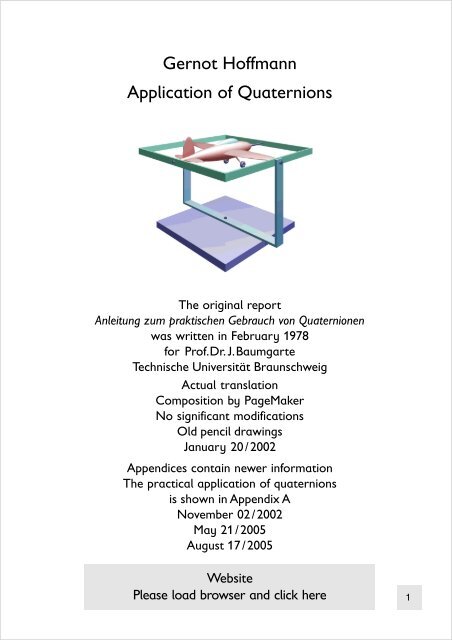



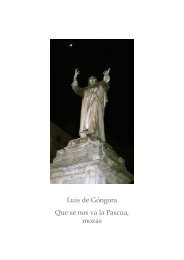
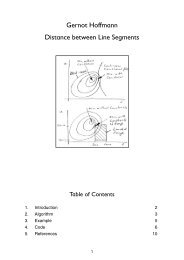
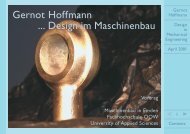
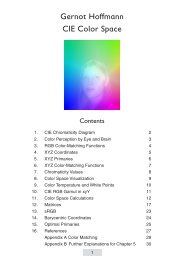
![[PDF] SpieleProgrammierung](https://img.yumpu.com/6860251/1/190x135/pdf-spieleprogrammierung.jpg?quality=85)
